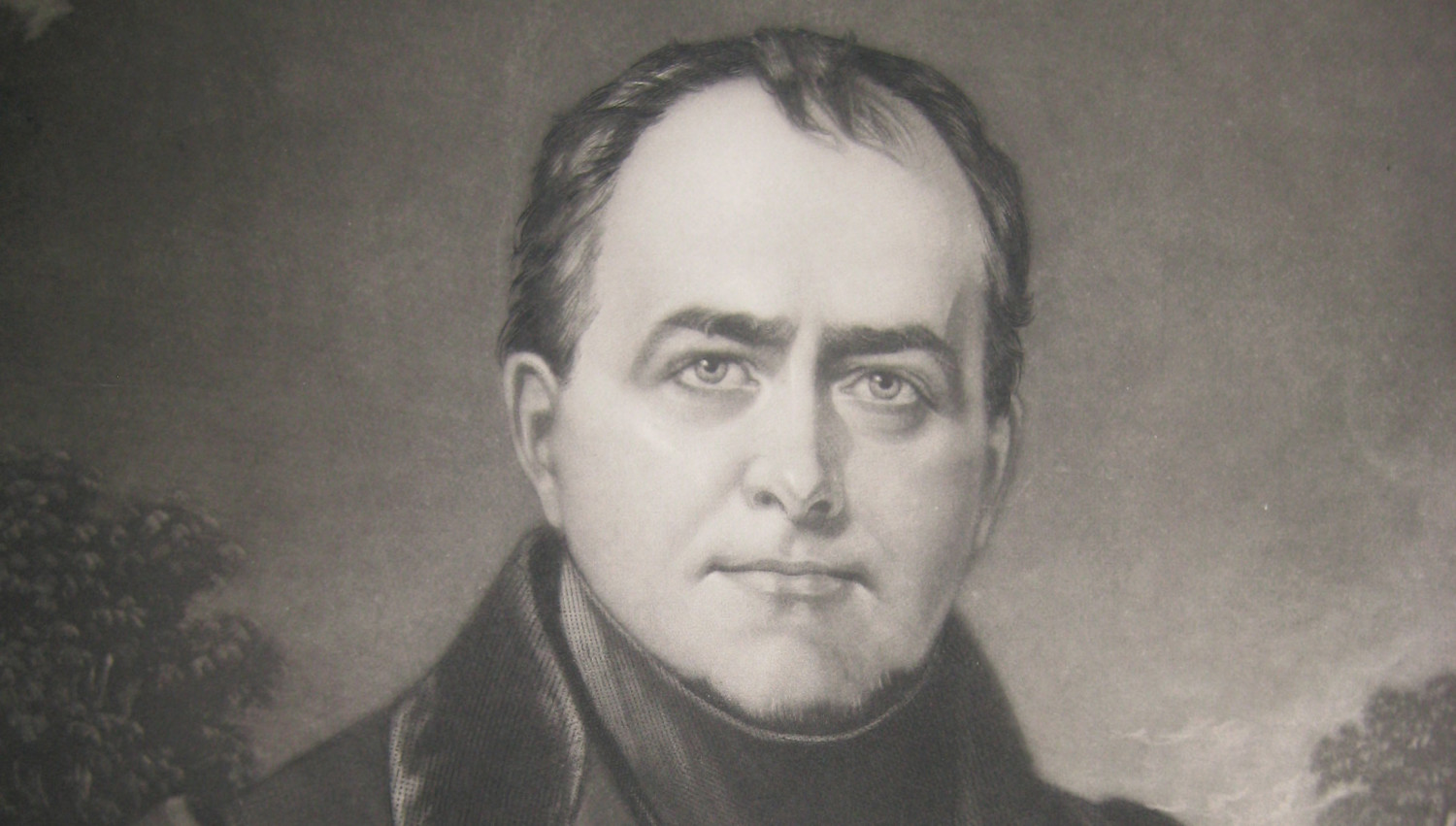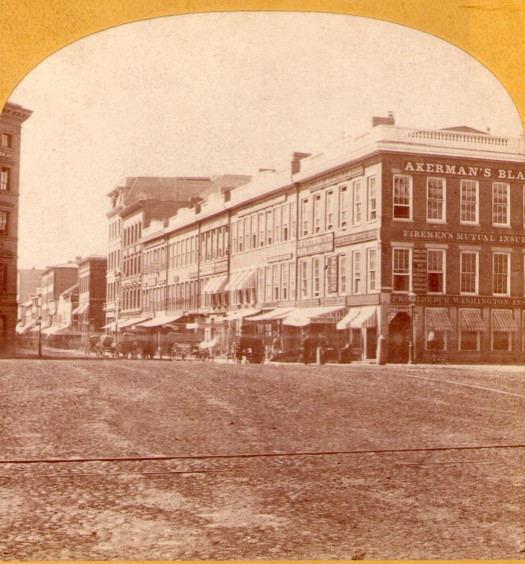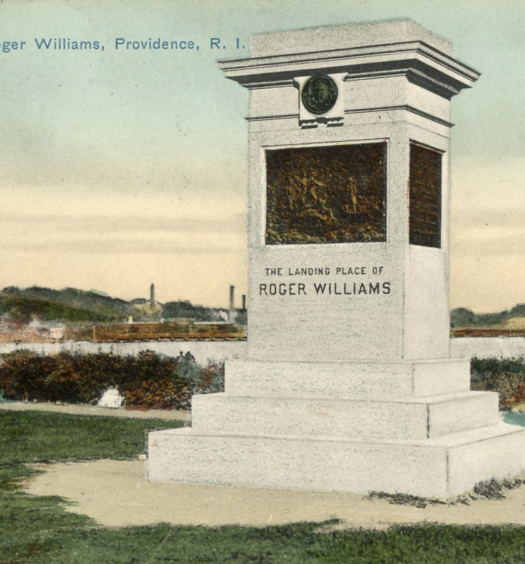Back in the late 1970s, while exercising shared custody of my four oldest children in the wake of a failed first marriage, my Sundays were a time for visits to every conceivable historic museum and site from Mystic Seaport to Sturbridge Village to Plymouth Rock to the Pilgrim Monument in Provincetown. The coverage given to Rhode Island landmarks was, of course, all-encompassing. My son, Pat Jr., a future history major and now an attorney, showed some enthusiasm for this historical odyssey; my daughters—Kathleen, Carolyn, and Sharon—endured it cheerfully. Their reward was a quarterly trip to the Stagecoach House in the village of Wyoming, in the town of Richmond, where its pleasant, generous, and genial proprietor, the late Domenic Bruno, provided them with a treasure trove of inexpensive costume jewelry. I showered my daughters with rings, bracelets, necklaces, berets, “gold” chains, and other sparkling heirlooms—all for five dollars or less.
On the second floor of Domenic’s eclectic emporium I found my own treasures: antiques, ephemera, and rare out-of-print books. At that time (and from 1963 to 1998), I operated Patrick T. Conley Books, which then had an inventory of approximately 22,000 volumes. Most were acquired in bulk from private estates, from small, defunct village libraries (such as the Lakewood Library in Warwick), and from public and college libraries that regularly prune their collections and discard surplus books. Some were “cherry-picked” at reasonable prices from dealers like Domenic. My sales were mainly via mail to other specialized dealers and to college and university libraries.
One autumn Sunday afternoon in 1978, on a visit to the Stagecoach House, I happened upon a thick scrapbook. Its leather covers were worn, chipped, and brittle. I opened one end to find pasted, page-upon-page, newspaper and magazine clippings from the 1830s. It seemed an interesting item, but nothing unusual or readily marketable to a university library. As I proceeded to examine the thick volume, I came upon a handwritten section, which was upside down in relation to the clippings. When I turned the book over, my eyes stared in disbelief at what I immediately recognized as the handwriting of Thomas Wilson Dorr, Rhode Island’s great nineteenth-century crusader for equal rights.
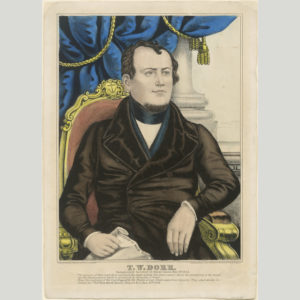
Thomas Dorr, “Inaugural Governor of Rhode Island, May 30, 1842. Circa 1844 (National Portrait Gallery)
I had just published (under the imprint of the Rhode Island Historical Society) a detailed constitutional history of early Rhode Island culminating with the Dorr Rebellion, and I had recently waded through fourteen volumes of Dorr correspondence in the archives of Brown University’s John Hay Library, plus one hundred folders of Dorr papers and another forty-six volumes of Dorr manuscripts. These documents covered Dorr’s role in such public reform efforts as banking regulation, curtailment of government granted monopolies, antislavery, abolition of imprisonment for debt, free public education, and comprehensive constitutional change.[1]
Dorr himself had carefully compiled these materials with an eye towards posterity. Following his treason trial and conviction in 1844, he hoped they would ensure his ultimate vindication. At the conclusion of that unjust and prejudicial trial, Dorr had defiantly addressed the draconian and highly partisan Chief Justice Job Durfee and his vengeful prosecutors: “From the sentence of the court I appeal to the People of our State and our Country. They shall decide between us. I commit myself without distrust to their final award.”[2]
Upon the reformer’s death in December 1854 at the age of forty-nine, Dorr’s voluminous papers were given to his friend, defender, and colleague Walter S. Burges, who later became an associate justice of the Rhode Island Supreme Court. Then they passed into the care of Sidney S. Rider, a noted Rhode Island collector, antiquarian, and constitutional historian. Rider augmented them considerably with other Rhode Island material and sold this historical treasure trove to financier and industrialist Marsden Perry, who in turn donated the papers to Brown University.
Having examined this voluminous collection at Brown University’s John Hay Library, I was well acquainted with Dorr’s legible penmanship, and—or so I thought—very well acquainted with Dorr himself. The Dorr collection dealt mainly with his public career, revealing a man possessed of a passion for equal rights via political, constitutional, economic, and social reform; a person who was articulate, intense, dedicated, persistent, bold, optimistic, and sometimes naive.
As I held this newly found volume in my hands, my initial reaction was this: “What more can I learn about Thomas Dorr from his account of the lectures of New York’s Chancellor James Kent, or from a batch of variegated clippings containing material written by others?” That thought prompted me to consider the compilation a mere artifact, yet a curiosity and keepsake well worth the five dollars that Domenic charged me to buy it. In the years following, I kept the volume in my library, showed it to those few who had an interest in Rhode Island historical items, and even displayed it at the Rhode Island Historical Society in 1992 during that organization’s commemoration of the Dorr Rebellion’s 150th anniversary (a project that I chaired).
That sesquicentennial observance inspired a new wave of Dorr devotees. Scholars such as Erik Chaput, Russell DeSimone, Dan Schofield, Joyce Botelho, Mark S. Schantz, Ron Formisano, Daniel P. Jones, Christian Fritz, Howard R. Ernst, Susan H. Graham, and Raymond Lavertue have offered new perspectives on Dorr and his movement that I could not relate with detail in my constitutional history, a book that covered a span of twenty-two decades (1636-1854). Such topics include the role of women in the rebellion and in the campaign to liberate Dorr (Formisano and Graham), the theoretical basis of Dorr’s constitutional doctrine (Formisano and Fritz), the historiography and the broader national impact of the rebellion (Chaput), the abortive military activity (Ernst), illustrative and anecdotal aspects of this era (DeSimone, Schofield, and Botelho), the role of Protestant sectarianism (Schantz), and a detailed biographical analysis of young Thomas Dorr (Lavertue).[3] In addition, I have followed my initial work with analyses of the long-range political and constitutional implications of Dorr’s defeat, the role of Dorrites in the murder trial of John and William Gordon, Dorr’s educational reforms, and the national response to the Rhode Island rebellion.[4]
When I told Dorr scholar Erik Chaput, a voracious researcher, that I possessed a Dorr notebook/scrapbook purchased from Domenic Bruno long ago, he immediately requested to examine it. Not wishing to be scooped by an article emanating from a find that I had initially considered of little scholarly value, I removed my ill-fitting real estate developer’s hat and finally began to read the aged and fragile tome in its entirety. Surprisingly, my image of the real Thomas Dorr was measurably enhanced. The following description of that volume reveals why.
The endpaper on the clipping portion of the book contains this notation: “Law Book belonging to Thomas Dorr, R.I., Henry Dorr.” Obviously this tome escaped the grasp of Rider, and apparently Thomas Dorr did not consider it of sufficient importance to include in the documents he entrusted to Walter Burges. Dorr’s younger brother Henry kept the law school notebook as a memento. How it passed from his estate and into the possession of Domenic Bruno in Richmond, nearly a century after Henry’s death will forever be a mystery.
Henry, who, like Thomas, remained a bachelor, was much more conservative than his older, ardent sibling. In January 1842 Henry wrote to Thomas that most of the huge outpouring of voters who had just approved the People’s Constitution would bow before a show of force by the existing government. If the Suffragists persisted, he admonished, “they would be like the Chartists of England with a few leaders, and those men not the right men to head such an enterprise–and no people on which you can depend to support you at all risks.” The younger Dorr proved to be a prophet indeed![5] He later proved to be a fine historian as well, writing, among other essays, The Planting and Growth of Providence. In 1882 Sidney Rider published Henry’s interesting and detailed municipal history that extended from the time of Roger Williams through the end of the eighteenth century.[6]
Dorr labeled my keepsake volume “Lectures of Chancellor Kent, New York, 1824-5, Part III On the Sources of Municipal Law and the Law Concerning Personal and Domestic Rights.” The lecture notes, compiled when Dorr was in his very late teens, comprise seventy-nine tightly written and numbered pages dealing with lectures twenty-one to twenty-five. They fill only one-quarter of the thick volume. One might deduce that there was another notebook filled with Dorr’s distillation of Kent’s lectures one through twenty, but its existence or whereabouts is unknown.
Dorr took two courses of lectures with the politically conservative Kent, the first from February through May 1824 and the second (recorded in my volume) from November 1824 to April 1825. Delivered at Columbia University, these lectures became the basis of Kent’s influential and erudite Commentaries on American Law.
Since Kent was young Dorr’s legal mentor, I selected a volume of the chancellor’s Commentaries for Dorr to cradle in the left arm of the sculpture my wife Gail and I commissioned for display at the long-awaited but as yet unrealized Heritage Harbor Museum.[7] As I earlier suspected, however, the law notes reveal only that Dorr was a meticulous, methodical student who thoroughly digested the material presented to him by Kent.
One claim in Kent’s Commentaries was incorrect. In discussing the evolution of judicial review, Kent stated that the 1795 Connecticut case of VanHorne’s Lessee v. Dorrance was the earliest decision in which a federal court invalidated a state law on the grounds that it conflicted with the U. S. Constitution. My researches, and especially those of my lawyer son, Patrick Jr., have shown that this distinction belongs to the 1792 Rhode Island case of Champion and Dickason v. Silas Casey.[8]
Now I move to the real revelation—the story disclosed by 159 unnumbered pages of newspaper and magazine clippings neatly pasted by Dorr into the unused portion of his law school notebook. These items were randomly selected with no topical pattern. This task was performed between 1835 and 1840, when Dorr (born on November 5, 1805) was in his early thirties.
The initial scrapbook entry is a firsthand account of the execution by American rebels of British major John André (1750-80), the spy who collaborated with Benedict Arnold (the great- grandson of Rhode Island’s first governor of the same name) to surrender the American fort at West Point. Later excerpts detail the 1649 regicide of King Charles I by his Puritan adversaries and the execution of British adventurer and explorer Sir Walter Raleigh (1552-1618) on a trumped-up charge of treason. Common to each of the three deaths—André on the gallows, Charles and Raleigh on the chopping block—was the calmness, courage, dignity, and nobility with which each condemned man faced his grim demise.
Before discussing other contents of the scrapbook, I should mention my surprise to see that it was nearly devoid of politics, partisanship, or discussion of the reform issues that filled Dorr’s public life. There is no evidence therein of Dorr the civic leader. Instead, what he chose to preserve revealed his personal tastes, thoughts, interests, desires, apprehensions, and predilections. The volume depicts Dorr up close and personal. I have written elsewhere that Dorr “had a searching and inquiring mind that ranged with facility through the fields of theology, literature, economics, science, and, of course, history.”[9] His scrapbook not only reinforces but also expands that earlier assessment.
Unbeknownst to me (and to others who wrote about him), Dorr had a great sense of humor. Many of his clippings espouse the importance of laughter (“Life Saved by Laughter”) and abound with humorous and amusing anecdotes. Witticisms expressed in the dialect of Celts or Afro-Americans—groups whose causes he championed—often caught his eye, as exemplified by the following: “Are you guilty or not guilty,” said the clerk of the arraigns to a prisoner one day. “And sure now,” said Pat, “what are you put there but to find out!”
Those essays dealing with religion that Dorr clipped from magazines and newspapers indicate a pious yet ecumenical attitude. Though deeply spiritual, he was tolerant of all beliefs and cordial towards Roman Catholicism. His clippings echo the favorable and admiring sentiments he expressed in April 1833 when writing to the Reverend Dr. Thomas J. O’Flaherty, vicar general of the Diocese of Boston, in reaction to the Catholic physician-priest’s three-hour defense of his faith from the rostrum of the Providence Town House. In that public letter, Dorr urged “the cultivation of kind, cordial, affectionate and benevolent feelings toward the division of the Christian Church.”[10]
Dorr saved several essays on American manners and morals written by British and French commentators, as well as numerous poems, mostly by English romantic writers. Eyewitness accounts from the Revolutionary Era often caught his attention. George Washington appeared to be his hero.
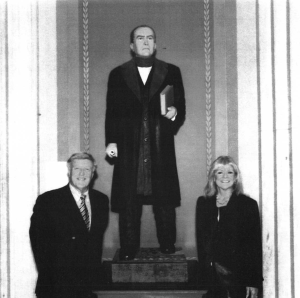
Patrick and Gail Conley at the November 5, 2014 dedication of the Thomas Dorr Sculpture at the entrance to the State Senate Chamber. (Author’s Collection)
Dorr’s chosen essays extolled the value of temperance, emphasized the importance of perseverance, prized the virtues of modesty and humility, and disdained vanity. Many of his choices condemned laziness and the idleness of the “loafer,” whether this vice resulted in the impoverishment of the slacker or the “uselessness” of the idle rich—those whom later critics would derisively call “the leisure class.” Concerning the latter, one sarcastic observation reflects the opinion of Dorr himself, the eldest son of a merchant prince, towards others of his class who lacked his civic commitment and drive: “He gets up leisurely, breakfasts comfortably, reads the papers regularly, dresses fashionably, lounges fastidiously, eats a tart gravely, talks insipidly, dines considerably, drinks superfluously, kills time indifferently, sups elegantly, goes to bed stupidly, and lives uselessly.”
Dreaming of foreign lands, Dorr seemed fascinated by scenes, customs, and events in Europe, the Far East, and South America. He also showed a penchant for items describing occurrences that were curious or bizarre. He saved numerous stories regarding longevity and the lives of those people around the world who had survived for a hundred years or more.
Above all, the scrapbook doted on women, courtly love, and marriage. He saved the works of “poetesses” and female writers, and he admired stories about women possessed of beauty, grace, and strength.[11] Essays or poems such as “Female Friendship,” “Kissing,” “The Bridegroom’s Dream,” “The Bride,” “What is Love?” and “A Chapter for Young Husbands” are scattered throughout the scrapbook. Concerning the latter, one wit offered a quip that Dorr collected: “Why are good husbands like dough? Because women knead them!”
More poignant than humorous is this romantic verse kept by Dorr in his scrapbook:
I WANT A WIFE
I want a Wife–not fat nor lean, But middling–that’s to say between,
She will not do if she be old–Nor yet a scold.
If she be short–or saucy shrew, Or over tall, she will not do; Nor any gaudy Miss–
Eager to kiss!
She must be fair–but must not paint her cheeks; and meek, but not a saint;
She must be young–about a score–or a little more.
She must have wit and sparkling eyes, And have good sense–but not too wise,
Her tongue, it must not be too long–No–that I’ll shun.
Her hair in ringlets too must play O’er either cheek;–she must be gay–
Her bosom must with fondness swell; I like it well.
Her mouth must always wear a smile, Her heart be ever free from guile;
And then her breath–why sure ‘tis meet, It should be sweet.
Her teeth–I vow they must be white, And lips as coral, not too light;
Her face, then must not be blotched, With too much red.
And one thing more, (if ‘tis my fate to enter in the marriage state;)
I must have money with my wife; This sweetens life.
She may persuade, but not command, I must be master ever–and
She must not for all her riches, Wear the breeches.
Now if any fair possessing those charms, if not too short or tall,
Be willing–I will share my bed, and her I’ll wed.
Why did Dorr fail to fulfill this want? He was witty (as his scrapbook displays), intelligent, highly educated, sensitive, sincere, ardent, romantic, well-to-do, the possessor of high social standing, and much better than average looking (as we can see from his daguerreotype image). Was he excessively shy and awkward in romantic situations? Was he too choosy, particular, and selective like the author of the poem? Was he too zealously and incessantly absorbed in his varied reform projects and by the hectic, disruptive life he led from 1840 until his prison stay broke his heart and his health? Did he favor a woman off-limits to him and beneath his class and social station? (There are hints of this in his clippings.) Having entered into more than one marriage myself, I am bewildered by the gap between Dorr’s strong desires and his failure to secure a bride. Some historians may suggest that this aspect of Dorr’s life be subjected to the insights of psychiatry, but I was never a devotee of that passing fad professionals call “psychohistory”; surely it is impossible to properly psychoanalyze the dead. It seems that Dorr’s unrequited want will remain a source of wonder.
By the time Dorr was released from prison, he felt, perhaps being too harsh on himself, that it was too late for him to marry. Speaking in the third person, Dorr wrote in a magazine article that “the worst thing about Mr. Dorr is his celibacy; and he is now so old and lame, besides having been in the State Prison, that his chance is pretty much gone.”[12]
When I finished my examination of this volume of clippings, my principal feeling was sadness. I realized that despite Dorr’s ecumenism, anti-Catholic nativism doomed his constitutional cause; despite his fascination with foreign lands, he never traveled beyond the borders of America; and despite his love of laughter and sociability, he endured public censure, rejection by his family, save only his mother Lydia, and many gloomy months of solitary imprisonment in a dark, dank cell.[13] Despite his desire to become a centenarian, he lived less than half that span of years; and despite his ardent wish for a wife, he died a bachelor. However, I take solace that in defeat, Dorr, like a tragic Greek hero, achieved immortality.
(Banner image: Thomas Wilson Dorr (Russell J. DeSimone Collection)
[1] Democracy in Decline: Rhode Island’s Constitutional Development, 1776-1841 (Providence: Rhode Island Historical Society, 1977).
[2] Ibid., 378.
[3] See Erik Chaput, “The Rhode Island Question: The Career of a Debate,” Rhode Island History 68 (summer/fall 2010): 46-76, a superb historiographical analysis, and the following select studies: Russell J. DeSimone and Daniel E. Schofield, comps., The Broadsides of the Dorr Rebellion (Providence, 1992); Joyce M. Botelho, ed., Might and Right: The Dorr Rebellion and the Struggle for Equal Rights (Providence, 1992); Mark S. Shantz, Piety in Providence: Class Dimensions of Religious Experience in Antebellum Rhode Island (Ithaca, N.Y., 2000); Ronald Formisano, “Role of Woman in the Dorr Rebellion,” Rhode Island History 51 (1993): 89-104, For the People: American Populist Movements from the Revolution to the 1850s (Chapel Hill, N.C., 2007), and “Rhode Island and the People’s Sovereignty, 1776-1843, in Patrick T. Conley ed. Constitution Day: Reflections by Respected Scholars (Providence, 2010), 186-210); Daniel P. Jones, The Economic and Social Transformation of Rural Rhode Island, 1780-1850 (Evanston, Ill., 1992); Christian Fritz, American Sovereigns: The Constitutional Legacy of the People’s Sovereignty before the Civil War (New York, 2008); Susan H. Graham, “ ‘Call Me a Female Politician, I Glory in the Name Women Dorrites and Rhode Island’s 1842 Suffrage Crisis’” (Ph.D. dissertation, University of Minnesota, 2006); Raymond Lavertue, “The People’s Governor: Thomas Wilson Dorr and the Politics of Abnegation, 1834-1843” (Ph.D. dissertation, Oxford University, 2011); Erik J. Chaput, “Thomas Wilson Dorr and the Rhode Island Question: The Competing Politics of the People’s Sovereignty in Jacksonian America,” (Ph.D. dissertation, Syracuse University, 2011), which was expanded and published as The People’s Martyr: Thomas Wilson Dorr and His 1842 Rhode Island Rebellion (Lawrence, Kansas, University Press of Kansas, 2013); and Howard R. Ernst, “A Call to Arms: Thomas Wilson Dorr’s Forceful Effort to Implement the People’s Constitution,” Rhode Island History, 66 (2008):59-80. I wrote on the back of the dust jacket of The People’s Martyr book, “Chaput’s new and meticulously researched analysis, linking the rebellion’s doctrine of popular sovereignty to abolitionism and the crisis of Union, establishes better than any preceding work the national impact of Rhode Island’s campaign for equal rights.”
[4] Patrick T. Conley, “Thomas Wilson Dorr: Rhode Island’s Foremost Political Reformer” and “Death Knell for the Death Penalty: The Gordon Murder Trial and Rhode Island’s Abolition of Capital Punishment,” in Conley, ed., Liberty and Justice: A History of Law and Lawyers in Rhode Island (Providence, 1998), 238-41 and 276-83; Conley, “No Tempest in a Teapot: The Dorr Rebellion in National Perspective,” Rhode Island History 50 (1992): 66-100; Conley, “Popular Sovereignty or Public Anarchy? Americans Debate the Dorr Rebellion,” Rhode Island History 60 (2002): 71-91; Conley, “Thomas Dorr: Neglected Educational Reformer” and “The Constitution of 1843: A Sesquicentennial Obituary” in Conley, Rhode Island in Rhetoric and Reflection (Providence, 2002), 116-27 and 170-81. See page 6 of Dorr’s notebook.
[5] Henry C. Dorr to Thomas Wilson Dorr, January, 1842, Dorr Correspondence, Volume 3, Rider Collection, John Hay Library, Brown University.
[6] Henry C. Dorr, The Planting and Growth of Providence, No. 15 of the Rhode Island Historical Tracts, Sidney S. Rider, ed. (Providence, 1882).
[7] James Kent, Commentaries on American Law (New York, 1826-28, 1830). The sculpture was done by Joseph Avarista. See Conley, “Thomas Wilson Dorr: The Man and the Monument,” in Rhode Island in Rhetoric and Reflection, 163-67. The sculpture of Dorr was temporarily located at the Fabre Line Club in the Conley’s Wharf Building on Allens Avenue in Providence from 2006 to 2013. In January 2014, it was moved to the Rhode Island State House where it now stands on a pedestal at the entrance to the state Senate Chamber.
[8] Patrick T. Conley, Jr., “The First Judicial Review of State Legislation: An Analysis of the Rhode Island Case of Champion and Dickason v. Casey (1792)” in Conley, Liberty and Justice, 216-23; and Conley Democracy in Decline, 162-63, note 1. See also Patrick T. Conley, ed., Constitution Day, 13-14.
[9] Patrick T. Conley, The Dorr Rebellion: Rhode Island’s Crisis in Constitutional Government (Providence, 1976), 13.
[10] Sidney S. Rider, “Leaf Out of Rhode Island History,” Book Notes 32 (March 13, 1915): 41-46. In January 1843, with Dorr in exile, the Providence Daily Journal observed that “Romanism and Dorrism are in sympathy with each other in certain principles and measures tending to subvert all our social institutions. . . .” Providence Daily Journal, January 12, 1843.
[11] In view of the respect and solicitude Dorr revealed for women in his scrapbook, it is most fitting that Ronald Formisano and Susan Graham have shown that Rhode Island ladies made their political debut in the Dorr Rebellion and that the spirited drive to liberate the imprisoned People’s Governor was their coming-out party.
[12] Dorr Manuscripts, Box 3, Folder 4, Brown University Archives. Russell DeSimone brought to my attention the short biographical sketch Dorr provided to John L. O’Sullivan, for inclusion by O’Sullivan in his popular magazine, the Democratic Review, which contains this quote. For Dorr’s interaction with O’Sullivan and his Democratic Review, see my essay, “Popular Sovereignty or Public Anarchy? America Debates the Dorr Rebellion,” Rhode Island History, (60 Summer 2002), 71-91.
[13] Dorr served about eight months in a Newport prison awaiting trial and twelve months of his life sentence in solitary confinement at the state prison in Providence prior to his “liberation” on June 27, 1845 after a state and national outcry to overturn the harsh sentence imposed upon him by Chief Justice Job Durfee. Congressman Elisha R. Potter Jr., a moderate Law and Order advocate, observed in the spring of 1845 that many of Dorr’s opponents knew that Dorr “was subject to violent attacks of acute rheumatism, and they feared that, if he should die in prison,” enemies of the existing government would “derive great emotional support from the people.” Elisha R. Potter to Thomas Potter, April 4 and May 18, 1845, Potter Collection, Rhode Island Historical Society.

